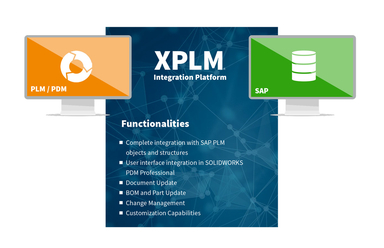How many issues with other departments do you think your employees resolve by email, telephone or in-person discussions over the course of a project? Probably more than you can count.
Digitised processes with continuous data flows between your ERP and PDM/PLM systems can make many of these unnecessary. Bidirectional exchange of documents and objects, parts lists and article information will improve your processes, shorten your lead times and reduce your project costs. Here are some examples:
- Centrally maintained item master data in the ERP that you automatically synchronise with the component libraries of your CAD tools via PLM system. This means that your designers will only be using current and relevant components.
- When a new BOM is stored in the PDM/PLM system, our direct integration generates an EBOM in accordance with your specifications. It is transferred to SAP and transferred to an MBOM for production planning, material procurement, etc.
- EBOM and MBOM remain connected, which facilitates rapid communication of subsequent product changes with the other departments. This cross-departmental change management creates transparency, enabling you to involve your production team in the product development process at an early stage. Products go into production immediately after their approval – without subsequent costly engineering adjustments.
In general, digital collaboration does not just reduce the time required and the sources of error caused by manual processes, it also removes the communication hurdles between technical and commercial departments, creating transparency for the right decision.
The item data provides every user with the information he/she needs
Well-maintained article master data provides all the information that users of the ERP, PDM or PLM system require for their work. Users in the various development domains work with the component library of their CAD system, which is synchronised via the PLM system with the ERP material master data. The other departments use the item master data managed in SAP ERP.
In engineering, the developers select the right components based on the technical data. The material master data is completed with data sheets, specifications, drawings, photos, etc. For example, the status of an item can be used to block components that have been discontinued by the manufacturer so that they can no longer be selected, but the successor linked to the item can be. The developer is then no longer allowed to select the corresponding component in his domain and must use an alternative. If the design department updates or adds a component, that will be taken into account during the next synchronisation run, as will the adjustments by the ERP.
Purchasing benefits from electronic transfer of the parts list, which it can immediately begin to process. Because the CAD-PLM integration checks the parts list, the purchasing department can be sure that it is complete and conforms to the design. . It immediately identifies items with a long delivery time and orders them in good time. It also recognises the items marked as those provided by the customer – which it does not order. In the event of product changes or expansions, the differences are identified so that there is no need to determine them manually.
The parts list – A relevant tool for closed-loop innovations
When storing a new CAD parts list, our CAD-PLM integration generate an EBOM. In PLM, it defines and manages the product with its variants along with the corresponding components, if applicable. It states how the functional structure is executed.
Unlike the CAD parts list, the hierarchical EBOM structure maps the structure of the assemblies, sub-assemblies and individual parts, and links the components to explanatory information such as specifications, data sheets, CAD files, calculations, models, etc.
The CAD parts list and EBOM are transferred to your ERP system via the interface, where the EBOM is transferred to an MBOM. This enables the production planners to structure the components used in accordance with best manufacturing practices in order to plan work and assembly steps. In the ERP system, the components can be linked with information such as 3D models, photos, assembly instructions, tool lists, or NC programmes.
If the developers adjust their design, the parts list and EBOM will be changed automatically. Once the EBOM is connected to the MBOM, the changes also flow into the MBOM, or the ERP users will be notified. This means that the new version in the EBOM triggers an alignment with the MBOM.
Continuous, bidirectional data flows between CAD, PDM/PLM and ERP systems eliminate any media discontinuities. On the contrary – secure processes streamline your product development process, and shorter innovation cycles increase your project throughput.
We offer the following SAP ERP integrations:
- SAP ERP - SOLIDWORKS PDMP
- SAP ERP - Aras Innovator
- SAP ERP - Oracle Agile EDM
- SAP ERP - Soft- und Firmware
